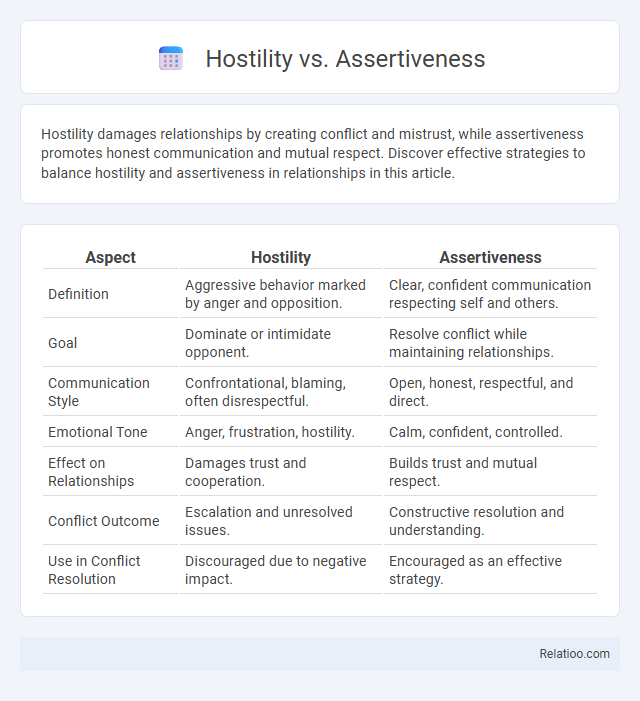Hostility damages relationships by creating conflict and mistrust, while assertiveness promotes honest communication and mutual respect. Discover effective strategies to balance hostility and assertiveness in relationships in this article.
Table of Comparison
| Aspect | Hostility | Assertiveness |
|---|---|---|
| Definition | Aggressive behavior marked by anger and opposition. | Clear, confident communication respecting self and others. |
| Goal | Dominate or intimidate opponent. | Resolve conflict while maintaining relationships. |
| Communication Style | Confrontational, blaming, often disrespectful. | Open, honest, respectful, and direct. |
| Emotional Tone | Anger, frustration, hostility. | Calm, confident, controlled. |
| Effect on Relationships | Damages trust and cooperation. | Builds trust and mutual respect. |
| Conflict Outcome | Escalation and unresolved issues. | Constructive resolution and understanding. |
| Use in Conflict Resolution | Discouraged due to negative impact. | Encouraged as an effective strategy. |
Understanding Hostility and Assertiveness
Hostility involves aggressive behavior intended to harm or dominate, often leading to conflict and damaged relationships. Assertiveness is the confident expression of one's needs and rights without infringing on others, promoting clear communication and mutual respect. Understanding the differences between hostility and assertiveness enables healthier interactions by fostering direct yet respectful dialogue.
Key Differences Between Hostility and Assertiveness
Hostility involves aggressive, confrontational behavior intended to harm or dominate, whereas assertiveness is the confident expression of one's rights and opinions without infringing on others. Key differences include emotional tone, with hostility marked by anger and defensiveness, while assertiveness maintains calmness and respect. Assertiveness promotes healthy communication and conflict resolution, while hostility often escalates conflict and damages relationships.
The Psychology Behind Hostile Behavior
Hostile behavior often stems from deep-seated psychological factors such as perceived threats, unresolved anger, or insecurity, which trigger defensive or aggressive reactions. Unlike assertiveness that involves clear, respectful communication of Your needs, hostility is characterized by harmful intent or aggression that damages relationships and escalates conflicts. Understanding the underlying causes of hostility can help You develop healthier coping mechanisms and foster more effective interpersonal interactions.
Characteristics of Assertive Communication
Assertive communication is characterized by clear, direct expression of thoughts and feelings while respecting others' rights and boundaries, fostering mutual understanding and collaboration. Your ability to maintain eye contact, use confident body language, and employ a calm tone enhances assertiveness, distinguishing it from hostility, which involves aggression and disrespect. This style promotes problem-solving and positive relationships, avoiding the destructiveness of hostility and the passivity of non-assertiveness.
Negative Impacts of Hostility in Relationships
Hostility in relationships often leads to increased conflict, erosion of trust, and emotional distress, significantly damaging interpersonal bonds. Unlike assertiveness, which promotes clear and respectful communication, hostility breeds resentment and defensiveness, hindering effective problem-solving. Persistent hostility can result in long-term psychological harm and reduced relationship satisfaction for all parties involved.
Benefits of Being Assertive
Being assertive enhances effective communication by allowing you to express your thoughts and feelings clearly without aggression. This approach fosters mutual respect, improves relationships, and reduces misunderstandings compared to hostility, which often leads to conflict. Assertiveness empowers your confidence and decision-making, promoting personal and professional growth while maintaining emotional balance.
Recognizing Signs of Hostility in Yourself and Others
Recognizing signs of hostility in yourself and others involves identifying behaviors such as persistent irritability, aggressive body language, and verbal confrontations marked by sarcasm or anger. Hostility often manifests through clenched fists, raised voices, or refusal to engage calmly, which contrasts with assertiveness defined by clear, respectful communication of your needs and boundaries. Understanding these distinctions helps you manage interactions more effectively while fostering healthier relationships.
How to Cultivate Assertiveness Skills
Cultivating assertiveness skills involves practicing clear and direct communication while respecting others' boundaries and opinions. Techniques such as using "I" statements to express feelings, maintaining open body language, and setting firm but polite boundaries enhance self-confidence and reduce passive or hostile responses. Regular self-reflection and role-playing assertiveness scenarios help reinforce positive interpersonal dynamics and promote emotional intelligence.
Transforming Hostility Into Assertive Communication
Transforming hostility into assertive communication involves recognizing triggers and expressing feelings openly without aggression, which enhances mutual understanding and resolves conflicts effectively. Assertiveness allows you to set clear boundaries and advocate for your needs while respecting others, fostering healthier relationships and reducing tension. Practicing active listening and empathy can shift hostile reactions into constructive dialogue, empowering your communication skills.
Practical Tips for Maintaining Healthy Boundaries
Maintaining healthy boundaries requires balancing assertiveness without slipping into hostility, as assertiveness allows you to express your needs clearly and respectfully while hostility can damage relationships. Focus on using "I" statements to communicate your feelings, set limits firmly but kindly, and stay calm to prevent escalating conflicts. Your ability to recognize when you're crossing from assertiveness into hostility will help preserve mutual respect and foster effective communication.

Infographic: Hostility vs Assertiveness
 relatioo.com
relatioo.com